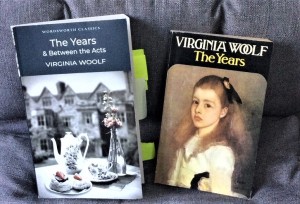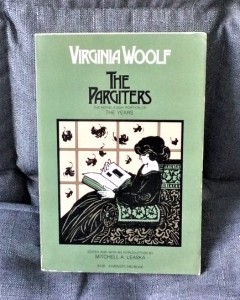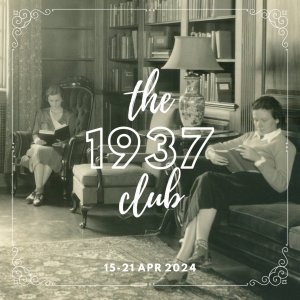My final book for 1937 is one which I was really looking forward to revisiting; it’s by a favourite author, but it’s one of her titles I suspect I’ve only read once, and that was longer ago than I’d care to acknowledge… I am, of course, talking about the truly wonderful Virginia Woolf and her book “The Years”.

The Wordsworth edition on the left is the one I read this time, as my old original copy on the right is a bit fragile now…
As I’ve no doubt rambled on about in the past, I first discovered her work in my early twenties and read everything I could get hold of (including the diaries and letters). She’s one of my favourite authors, and I’ve re-read some titles more than once (“Mrs Dalloway”, “To the Lighthouse”. “Flush” and “Orlando” spring to mind). However, there are others that I’ve only read the one time (as far as I can remember) and “The Years” is one of those. So I was going into it cold, in effect, with no real memory of the book or what it was about or what to expect. And I made a point of avoiding introductions or reading about it so I could have a pure experience; and in many ways it was like reading the book for the first time again, and I was equally blown away by it!
“The Years” tells the story of the extended Pargiter family over a period of time ranging for 1880 to what is designated as ‘The Present Day’ (so presumably in the 1930s), and as the book opens we’re introduced to the Colonel Abel Pargiter side; central to the story will be eldest daughter Eleanor, who’s somewhat in charge of household matters at the moment, as her mother Rose is ill in bed, dying. She has sisters, Milly, Rose and Delia; and brothers Martin, Morris and Edward. We meet each of these characters in the first section, finding out a little about them. Eleanor does good works; teenager Delia feels trapped by her mother’s illness and longs for her death; Martin is already a practicing barrister; Edward is studying at Oxford, and is in love with his cousin Kitty, who will also feature throughout the book. Ten year old Rose sneaks out to the toy shop but is frightened on the way home by a man exposing himself. Already, the patterns laid down for male and female in this Victorian world are clear.
The uproar, the confusion, the space of the Strand came upon her with a shock of relief. She felt herself expand. It was still daylight here; a rush, a stir, a turmoil of variegated life came racing towards her. It was as if something had broken loose—in her, in the world. She seemed, after her concentration, to be dissipated, tossed about. She wandered along the Strand, looking with pleasure at the racing street; at the shops full of bright chains and leather cases; at the white-faced churches; at the irregular jagged roofs laced across and across with wires. Above was the dazzle of a watery but gleaming sky. The wind blew in her face. She breathed in a gulp of fresh wet air. And that man, she thought, thinking of the dark little Court and its cut-out faces, has to sit there all day, every day. She saw Sanders Curry again, lying back in his great chair, with his face falling in folds of iron. Every day, all day, she thought, arguing points of law. How could Morris stand it? But he had always wanted to go to the Bar.
However, instead of using a simple, linear narrative, Woolf jumps ahead in each of her sections, focusing on a particular year and following her characters through the changes of their lives. We meet the cousins, children of Sir Digby Pargiter and his wife Eugenie; these are Magdalena (Maggie) and Sara (Sally), and the trajectories of their lives will be somewhat different to those of their relatives. Other characters feature, friends and servants and contacts, but always we return to the two families and the changes in their lives as society changes around them. World War 1 will affect some; others will travel abroad; marriages will take place which might not be the expected ones; and meanwhile the crowded dance of modern life, which Woolf always captured so brilliantly, continues. The book ends with an extended set piece in the then present day, a party attended by the surviving Pargiters where they’re contrasted with the younger generation and contemplate the modern world.
My life, she said to herself. That was odd, it was the second time that evening that somebody had talked about her life. And I haven’t got one, she thought. Oughtn’t a life to be something you could handle and produce?—a life of seventy odd years. But I’ve only the present moment, she thought. Here she was alive, now, listening to the fox-trot.
That’s a fairly simplistic summary of what is a deep, rich and quite wonderful book; and my experience of re-reading it has made me wish I went back to Woolf’s work more frequently. “The Years” is quite brilliantly constructed, and the clever way she moves forward in time for each section works wonderfully. Each is introduced by what I would call one of her panoramic sequences, where she notes the season of the year and casts her narrative eye over London and the countryside, summing up and describing the weather, what people are doing and how she sees the world. These are quite brilliant, and there are sequences like this in “Mrs Dalloway”, which frankly were what first convinced me of her genius.
She sat still for a moment; then undressed and paused with her hand on the blind. The train had got into its stride now; it was rushing at full speed through the country. A few distant lights twinkled here and there. Black clumps of trees stood in the grey summer fields; the fields were full of summer grasses. The light from the engine lit up a quiet group of cows; and a hedge of hawthorn. They were in open country now.
Woolf’s writing is just stunning in this book, as always, and I make no apology for including several quotes; I could have filled several posts with her words. She captures the interior and often fragmented thought processes of her characters, encompasses major events (death of the King, war, the Irish Problem), and takes the reader on a journey through the changing times over a period of 50 or so years. It’s a remarkable achievement, and quite unforgettable.
Yet, once again, I I found Woolf remarkably easy to read. Her prose is so beautiful it just hypnotises you, and I do wonder why she has a reputation for being difficult (or perhaps I’m just attuned to her writing?) Woolf’s intention was, I believe, to reflect the differing options for men and women, and how this changed over the years; certainly, in the early sections of the book, the female characters have a very narrow, proscribed set of life choices; and it’s only in the later parts that their opportunities widen, though marriage still seems to be considered the main choice. But Eleanor is restricted to good works; Kitty marries for money, as far as I can tell, despite loving someone else, and being attracted to a different way of life; and Maggie and Sally end up in unpromising lodgings with limited incomes. As well as being a beautiful read, there’s also much food for thought in “The Years”.
As I suspected, I remembered nothing of “The Years”, so it really was like reading it for the first time, and as always with Woolf I ended the book stunned. It was her penultimate novel and the last published in her lifetime, and I chose to pick up a Wordsworth Classics edition ((here collected with her last novel, “Between the Acts”); my original copy is too fragile and crumbly to risk reading. Interestingly, there were notes and annotations in this which aren’t of course in my 1980s original copy! I found that they were mostly unnecessary for me, but I guess a younger reader might find them helpful.
So reading “The Years” has been one of the highlights of what has been a really marvellous reading week for the #1937Club. I always reckon Virginia Woolf as one of my favourite authors, and this book has reminded me how much I love her writing. I’m definitely going to have to go back to some of the other titles I’ve not revisited in decades, but in the meantime I’m so happy to have ended our club week with some a wonderful book!
*****
As a coda, I wanted to give a little more background to “The Years” and comment on another book I’ve read alongside it. You see, my understanding is that Woolf’s original plan was not simply to write a novel, but to try something more audacious, along the lines of what she called a ‘novel-essay’. Embarking on this in 1932, she created a series of draft essays which were to be interspersed with extracts from a novel “The Pargiters”; these would be used to illustrate her points about what life was like for men and women, and how their experiences and opportunities differed so widely. This plan never came to fruition and instead she went on to write “The Years”.
However, her original intention has been recreated as far as possible by Mitchell A. Leaska and was published under the title of “The Pargiters: The Novel-Essay Portion of The Years”. I was so embroiled in Woolf that I picked this up straight after finishing “The Years” and I do think this is the best time to read it. “Pargiters” makes fascinating reading, as the focus is on the events of 1880 (opening) section of the final novel, and the essays expand on what was trying to say in her book. The chapter extracts are extraordinary as they have variant events, explore options which were abandoned in the final book and generally add much to any reading of “The Years”. Of course, the latter is such a brilliant book that it stands proudly on its own; but as a Woolf obsessive/completist, reading “The Pargiters” was an essential experience.
So I have ended our #1937Club week just as convinced as I ever was about the genius of Virginia Woolf. This post is probably much too long already, but it only scratches the surface of her work, and I could go on and on about her – but I’ll stop here. I’m just happy to have spent some wonderful hours lost on the prose of one of my favourite authors; a wonderful way to end our reading week!































